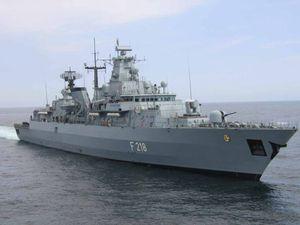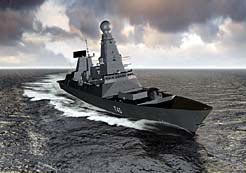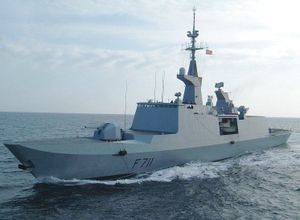Roudland Navy
Overview
The Roudland Navy is the branch of the Roudland Military responsible for protecting Roudland’s interests using the sea, whether that may be patrolling coastlines and shipping lanes in anti-piracy actions, to transporting Army units to foreign shores and providing air support to their operations. The Navy is a true blue-water force in that it has a multi-faceted fleet with numerous ship classes and abilities.
The primary role of the Navy is to enable the Army to complete its objectives. To this end, the Navy has three separate classes of transport ship that can carry men and materiel across the world’s oceans. These craft are then supplemented by destroyers and frigates to provide defence from sea and air attack for the Army as it is being transported. Finally, the Navy has carriers to provide support for the Army when it is on land, and submarines to provide fleet support, cruise missile support, and to be the location of Roudland’s nuclear deterrent.
The navy operates many different aircraft and landing craft, sometimes highly modified from their original Air Force and Army versions. In addition to this the Navy, in most other nations, is associated with Marines. This is not so in Roudland, where Marines are an amphibious unit that forms part of the Roudland Army. In their place, the Navy has Naval Commandos and WRAITHS SpecOps forces with which to conduct its own amphibious operations.
The Roudland Navy is undoubtedly one of the largest, most powerful navies on earth, and forms a vital part of Roudland’s strategic vision. There are several new vessels slated to join the fleet in mid to late 2007, such as the Emperor Class Assault Carrier, developed with Kegmenistan, a new class of amphibious landing ships, and there are plans for a second batch of Type 45s to be built.
Surface Fleet
Glorious Class Carrier
Glorious Class Aircraft Carriers (sometimes called ‘supercarriers’) are the largest and most powerful warships fielded by any Navy in the world. Powered by three nuclear reactors, they are over-powered even for their size, and so can travel almost as fast as a destroyer whilst having easily five times their displacement. Glorious Class Vessels have a very long range and the largest complement of aircraft yet seen on a carrier, and are more than capable of conducting amphibious and transporting operations, something usually reserved for the Wasp and Hornet Classes. They recently increased in number after the scrapping and subsequent auctioning of the remaining Atlas Class Light Aircraft Carriers and Hydra Class Dropship Carriers. The Glorious Class are being supplemented by the Emperor Class Assault Carrier, a hybrid aircraft carrier-amphibious assault vessel, in mid 2007.
Role: Aircraft Carrier: Provider of fleet and land support, command hub for operations
Crew: 3,200 ship’s company, 2,500 Air wing
Weapons: ESSM Anti-Air Missiles, Phalanx CIWS,
Aircraft Carried: 90 (Mix of F-35 Lightning IIs, EA-35 Thunderclap, RAH-68 Comanche, AH-67 Apache Longbow, Cherokee, Nighthawk, Rhino and Cobra Dropships)
Type 45 Destroyer
The Type 45 Daring Class Destroyer is the world’s premier destroyer. Developed by the Royal Navy of Great Wrightland and built at Swan-Hunter fleetyards in Southcomb, but used in far greater numbers by the Roudland Navy, the Type-45 makes up the mainstay of Roudland’s escort fleet. Carrying state of the art navigation, radar and weapons systems, the Type-45 also incorporates stealth technology into its design, rendering it a difficult target for long-range anti-ship missiles to detect and hit. It can be used in a multitude of roles, which has kept prices high but simultaneously given a good reasoning for those prices. They also have some troop deployment capability, carrying 120 Naval Commandos, along with three Cherokee Dropships.
Role: Capital Ship Escort: Anti-Air and Anti-Ship defence, shore bombardment
Crew: 230
Weapons: SYLVER Missile Launcher (firing Aster missiles), Phalanx Anti-Missile CIWS, 1 VAVRAG Gun, Seagnat countermeasures, Harpoon Anti-Ship Missiles, SLAM
Type 90 Frigate
The Zumwalt Frigate is the long-awaited replacement for the Type-67 ships that have been in service for up to 40 years. Smaller but by no means less well equipped than the Type-45s, the Zumwalt (or Type-90) frigates carry a large array of anti-ship weaponry, and are more than able to engage air targets effectively. The Type-90s have a stealth design which sets them apart from any other ship in the world, even the Type-45s. The stealth on the Type-90s enables them to travel, undetected, into enemy waters, as well as enabling them to engage enemy ships before they are seen on radar, thereby increasing the chances of a first strike kill. They also sport two 5inch variable velocity rail gun (VAVRAG) like those on the Type-45, but can only carry around 60 troops, along with two Cherokee Dropships. The Type-90 project is, at the moment limited to just twelve ships, as they are extremely expensive. The Navy has brought in two other frigate classes to aid the Type 45s and Type 90s.
Role: Anti-Frigate/Destroyer, Capital Ship Escort, Limited Air Defence, shore bombardment
Crew: 195
Weapons: SYLVER Missile Launcher (firing Aster missiles), Phalanx Anti-Missile CIWS, 2 VAVRAG Guns, Seagnat countermeasures, Harpoon Anti-Ship Missiles, Storm Shadow Cruise Missiles, ‘Checkmate’ Nuclear Stealth Cruise Missiles, SLAM
Hakkendorf Class Frigate

The Hakkendorf Class Frigate is a multi-role frigate designed to aid the Type-45, which is mainly air-defence, in a more conventional anti-ship and anti-submarine role. It incorporates multiple weapons systems to give all-round defence, and, like all new Roudland Naval vessels, has a highly sophisticated SAMSON-SMART-APAR hybrid radar system, developed by a conglomerate of RDC Systems, Avion Space Technologies and SWORD. It can engage ships at a distance of around 40 miles, and aircraft at a distance of 125 miles. Hakkendorf class vessels normally travel with Broadsword vessels, which are very heavily anti-ship.
Role: Multi-Role Air Defence/Sea Defence Frigate, Capital Ship Escort, Patrol Vessel
Crew: 210
Weapons: SYLVER Missile Launcher (firing Aster missiles), Phalanx Anti-Missile CIWS, 1 VAVRAG Gun, Seagnat countermeasures, Harpoon Anti-Ship Missiles, Spearfish Torpedoes
Broadsword Class Frigate
The Broadsword Frigate, along with the Hakkendorf class, are capital ship escorts in the anti-ship role. Moreso than any other ship, the Broadsword are designed to engage submersed vessels and those on the surface with anti-ship missiles and torpedoes. Less multi-role than the Hakkendorf, they require an air-defence escort themselves to be truly protected from air attack. Broadsword ships are also of a stealthy design, moreso than the Hakkendorf, but less than the Type-45 and Type-90. It is planned that once the Type-90 Frigate becomes the main frigate of the Navy, the number of Broadswords will be reduced.
Role: Capital Ship Escort, Anti-Ship Defence, Anti-Submarine Defence
Crew: 210
Weapons: SYLVER Missile Launcher (firing Aster and ESSM missiles), Phalanx Anti-Missile CIWS, 1 VAVRAG Gun, Seagnat countermeasures, Harpoon Anti-Ship Missiles, Spearfish Torpedoes, Naval Strike Missile, Storm Shadow Cruise Missile
Wasp Class Amphibious Assault Transport
The backbone of the Roudland Navy’s amphibious warfare capability comes courtesy of the Wasp class assault transports. Designed for infantry/vehicle landings needing a large amount of materiel or manpower, the Wasp class can carry two battalions of infantry, plus supporting vehicles, something that is currently unmatched in the rest of the Alliance. It also has a substantial wet dock within its hull, with which amphibious deployments are initiated, utilising LCAC hovercraft or conventional LCUs. The Wasp also can deploy small amounts of troops by air, utilising its flight deck and fleet of transport dropships. Combined with its air cover potential of VTOL F-35s and Longbow helicopters, the Wasp class is truly an awesome vessel, capable of carrying out allied operations virtually anywhere with relative impunity. It forms part of the Roudland 'Strike First, Strike Hardest' mantra, and has been exported to a number of other nation's navies, most notably Great Wrightland. The Wasp class gives Roudland the ability to intervene with armed force across the globe; there are 60 of these vessels in service, and they were used widely in the 3rd Moronyickan War, the Hannigan Island Conflict and the Southern Gulf War.Role: Assault Transport
Crew: 1,100
Troops Carried: 2,250
Landing Craft: LCAC, LCU, Viper, Rapier
Weapons: Phalanx CIWS, ESSM
Air Wing: 8 Apache Longbow, 6 F-35, 6 Cobra Mk3, 9 Rhino Mk7, 9 NightHawk
Hornet Class Assault Transports
The Hornet Class Assault Transports are the newest class of amphibious warfare vessel in the Navy, replacing the Superior and Cerberus class vessels. It is designed to act in tandem with a Wasp or Emperor class vessel group, and also maintains a larger number of heavy vehicles than other amphibious warfare ships, being capable of carrying up to 50 Challenger 2 MBTs as well as infantry and Warrior/Stryker IFVs. Housing a number of command centres as well as numerous communications suites, the Hornet can act as a command vessel for a ground force (or even a naval force if necessary) as well as a Glorious Class Carrier. Faster than the Wasp class, the Cerberus is equally fitted to protect itself and its cargo of Tanks, IFVs, jeeps and supporting infantry. It lacks a flight deck, thought it has several largelanding pads with which it deploys Apache gunships and Rhino/NightHawk/ Cobra dropships. It also has a wet dock, though lacks the necessity for LCACs, and so normally operates exclusively LCUs, thoughViper ALVs have been stored aboard during major conflicts. There are currently 35 in service, and they form a vital part of Roudland's foreign policy commitments; there are currently three deployed near the DSUT which are assisting the rebuilding process.
Role: Assault Transport/Command Vessel
Crew: 450
Troops Carried: 1,250
Landing Craft: LCAC, LCU, Viper, Rapier
Weapons: Phalanx CIWS, ESSM
Air Wing: 4 Apache Longbow, 4 Cobra Mk3, 6 Rhino Mk7, 6 NightHawk
Landing Craft
Landing Craft Air Cushioned
The LCAC is one of the more recent additions to the Roudland Navy, having entered service with the Wasp class in 1996. It is a fast, agile, heavily armed transporter used for moving men and vehicles to beachheads or areas not normally accessible by conventional transport craft. It can land whilst taking fire, and has been known to withstand rocket hits to the outer hull without severe damage and casualties. Coupled with the Wasp and Hornet class, the LCACs make the Roudland Navy a fearsome fighting force, and currently the largest amphibious landing contingent in the world, with the capability to deploy around 160,000 men and over 1000 armoured vehicles in one wave by sea alone. The LCAC itself can carry a force of five MBTs or 400 soldiers. It also has a compliment of three L7A2 MGs and a GMG for protection and troop support.
LCU (Landing Craft Utility)
The LCU is a heavy landing craft used for the purposes of getting men and materiel to and from beachheads and the like. It can carry up to 400 soldiers in a tightly packed formation, or three main battle tanks or equivalent armoured vehicles. Like all other Navy landing craft it can beach itself, and has been designed to be compatible with most vessels in the fleet; it is not uncommon to see a Type 45 or Hakkendorf Class Frigate deploying one LCU for its Marine force. It is armed with two L7A2 MGs and a GMG.
Viper ALV (Aggressive Landing Vessel)
The Viper ALV is a small, agile landing craft designed for landings involving small numbers of light troops or special forces. It can carry 16 troops or some small cargo, and is also used for patrolling waterways and logistics operations. It protects the troops with a full armoured canopy, unlike the partial canopy of the Rapier LCS. The Viper is found aboard all naval ships, as its size and utility makes it a favourite of most Marines and other soldiers. It sports twin MG4s for self-defence.
Rapier LCS (Landing Craft, Soldiers)
The Rapier LCS is a moderately sized landing craft, designed to fill a gap between the LCU and LCAC, and the Viper ALV. The Rapier can carry 80 troops in a partially enclosed and armoured canopy, and can be stored, like the LCU and ALV, even on the decks of a ship, as well as in its landing bays. They are protected by three L7A2 MGs, and are favoured by Rangers and other light troops.
Subamarines
Astute Class
Submarines remain the largest threat to allied ships. Because of this, a small, quick anti-submarine was created to hunt other subs. Armed with a large compliment of torpedoes, the Astute class are a formidable force, with advanced anti-sonar stealth technology. They can also deploy Storm Shadow and SLAM missiles.
Vanguard Class
The Vanguard Class submarine forms the main part of Roudland’s nuclear deterrent. There are over forty subs in service, each capable of deploying Trident III nuclear SLBMs. Little is known about the subs themselves, as the Navy keeps this a closely guarded secret. The Trident III missile has been revealed to the public as a SLBM with a range of 9500 miles and 16 independently targeted reentry vehicles, each capable of carrying a 20 megaton warhead. The Vanguards are constantly on patrol in international waters, and their location is not disclosed to the public.






